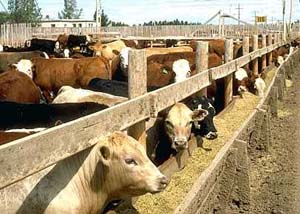
Agricultural News
OSU's Peel Says USDA Data Lapse Complicates Beef and Cattle Market Analysis
Mon, 02 May 2011 12:48:19 CDT
 Cattle and beef markets, like many other agricultural markets, are operating at historic and unprecedented levels. Oklahoma State University Extension Livestock Market Economist Dr. Derrell Peel says there is no doubt that markets have moved to a new level but there is a great deal of uncertainty about exactly what the operating range is for both production and prices. Market analysts, along with industry participants from cow-calf producers to restaurant and grocery retailers, are struggling to sort out domestic and international beef demand against 50-year lows in cattle inventories and the backdrop of a still weak U.S. economy and global unrest. Last week, in an unprecedented and unanticipated lapse, USDA failed to provide weekly livestock slaughter data. Moreover, USDA, in a statement provided in lieu of the reports that rely on the slaughter data, indicated that not only were the data unavailable, it is unknown when the data would be available. This adds significantly to the struggle to understand cattle and beef markets.
Cattle and beef markets, like many other agricultural markets, are operating at historic and unprecedented levels. Oklahoma State University Extension Livestock Market Economist Dr. Derrell Peel says there is no doubt that markets have moved to a new level but there is a great deal of uncertainty about exactly what the operating range is for both production and prices. Market analysts, along with industry participants from cow-calf producers to restaurant and grocery retailers, are struggling to sort out domestic and international beef demand against 50-year lows in cattle inventories and the backdrop of a still weak U.S. economy and global unrest. Last week, in an unprecedented and unanticipated lapse, USDA failed to provide weekly livestock slaughter data. Moreover, USDA, in a statement provided in lieu of the reports that rely on the slaughter data, indicated that not only were the data unavailable, it is unknown when the data would be available. This adds significantly to the struggle to understand cattle and beef markets.
Weekly slaughter and carcass weight data have been a key data flow for many years. These data are vitally important for two reasons. First, the weekly flow of estimated values, followed by actual slaughter values, represents the only near real-time information on meat production relative to currently observed market prices for cattle and beef. This provides the sole means to have a timely and reasonably complete picture of current supply and demand conditions. Secondly, slaughter data are direct data, and as such, are among the more reliable data available to the industry. Slaughter data provide a critical benchmark to validate statistically based measures such as cattle on feed and cattle inventory reports. Lack of ability to "true up" other data series against slaughter data will lead to reduced reliability of a much broader set of livestock industry data.
The reasons for the USDA's failure to provide the slaughter data is not entirely clear but appears to stem from two problems. First, the Food Safety Inspection Service (FSIS), the originating agency for slaughter data, does not seem to consider provision of this data a high priority. Secondly, like several data series, slaughter data passes through several USDA agencies on the way to being publically released. There appears to be a lack of emphasis on interagency cooperation, from the highest levels of USDA administration, to ensure that the data are provided and released in a proper and timely fashion.
This data issue is particularly disturbing because of the arbitrary and abrupt timing but it is by no means the only data issue facing the beef industry. Anticipating budget reductions, some USDA agencies have already proposed various reductions and eliminations of data that may have significant impacts on the beef industry. The National Agricultural Statistics Service (NASS), for example, has provided a list of possible data changes including changing from monthly Cattle on feed reports to quarterly reports; eliminating the July Cattle Inventory report; and changes to livestock slaughter data. Additionally, several changes in crop yield and production estimates are proposed which would reduce the ability of livestock industries to understand and anticipate feed market conditions.
While budget realities may necessitate some changes and reductions in various data, it is vitally important that producers and other industry participants communicate the uses of these data and the impacts of losing the data to appropriate agencies to ensure that well informed decisions result from the process of prioritizing changes in data collection and provision. With much of agriculture facing a fundamentally new and unknown environment, more data, rather than less, would seem to be called for. From the standpoint of producers, trying to sort out new market incentives and challenges, as well as for consumers, who are understandably concerned about food security and rising food prices, the need for USDA to maintain the role of primary provider of agricultural production and market price data is arguably more important now than any time in many years.
Our thanks to Dr. Peel for this latest analysis of the beef cattle marketplace- it's a part of the weekly Cow Calf Corner electronic newsletter that Dr. Peel and Dr. Glenn Selk of OSU produce on most Mondays.
WebReadyTM Powered by WireReady® NSI
Top Agricultural News
More Headlines...




















